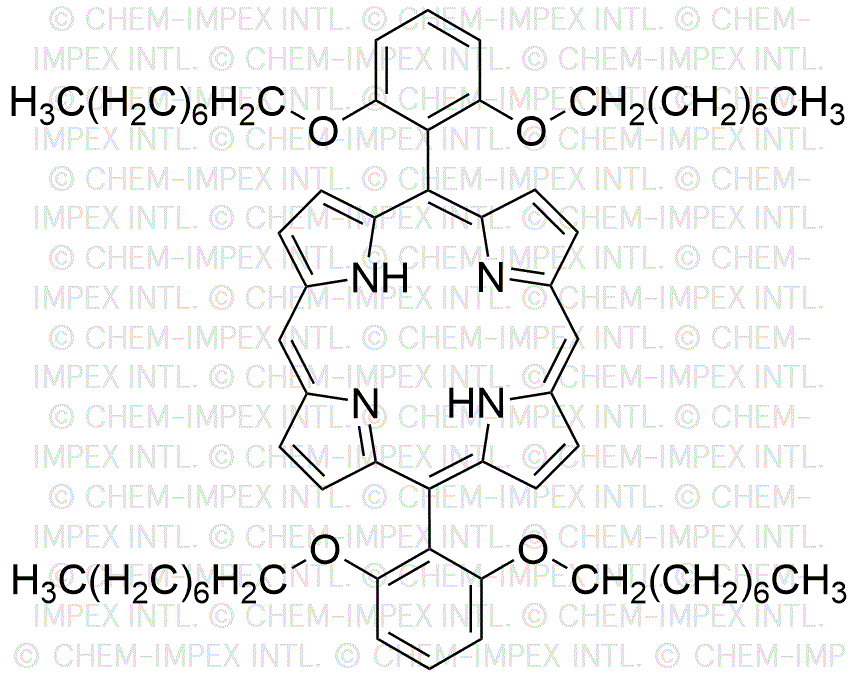5,15-(di-2,6-Octyloxyphenyl)porphyrin is widely utilized in research focused on:
- Solar Energy Conversion: This compound is used in the development of organic photovoltaic cells, enhancing light absorption and energy conversion efficiency.
- Photodynamic Therapy: It serves as a photosensitizer in cancer treatment, where it generates reactive oxygen species upon light activation, targeting and destroying cancer cells.
- Sensor Technology: Its unique optical properties make it suitable for creating sensors that detect environmental pollutants, providing real-time monitoring solutions.
- Material Science: This porphyrin is incorporated into advanced materials for electronics, improving conductivity and stability in organic semiconductors.
- Catalysis: It acts as a catalyst in various chemical reactions, offering a more efficient pathway for organic synthesis compared to traditional methods.
General Information
Properties
Safety and Regulations
Applications
5,15-(di-2,6-Octyloxyphenyl)porphyrin is widely utilized in research focused on:
- Solar Energy Conversion: This compound is used in the development of organic photovoltaic cells, enhancing light absorption and energy conversion efficiency.
- Photodynamic Therapy: It serves as a photosensitizer in cancer treatment, where it generates reactive oxygen species upon light activation, targeting and destroying cancer cells.
- Sensor Technology: Its unique optical properties make it suitable for creating sensors that detect environmental pollutants, providing real-time monitoring solutions.
- Material Science: This porphyrin is incorporated into advanced materials for electronics, improving conductivity and stability in organic semiconductors.
- Catalysis: It acts as a catalyst in various chemical reactions, offering a more efficient pathway for organic synthesis compared to traditional methods.
Documents
Safety Data Sheets (SDS)
The SDS provides comprehensive safety information on handling, storage, and disposal of the product.
Product Specification (PS)
The PS provides a comprehensive breakdown of the product’s properties, including chemical composition, physical state, purity, and storage requirements. It also details acceptable quality ranges and the product's intended applications.
Certificates of Analysis (COA)
Search for Certificates of Analysis (COA) by entering the products Lot Number. Lot and Batch Numbers can be found on a product’s label following the words ‘Lot’ or ‘Batch’.
*Catalog Number
*Lot Number
Certificates Of Origin (COO)
This COO confirms the country where the product was manufactured, and also details the materials and components used in it and whether it is derived from natural, synthetic, or other specific sources. This certificate may be required for customs, trade, and regulatory compliance.
*Catalog Number
*Lot Number
Safety Data Sheets (SDS)
The SDS provides comprehensive safety information on handling, storage, and disposal of the product.
DownloadProduct Specification (PS)
The PS provides a comprehensive breakdown of the product’s properties, including chemical composition, physical state, purity, and storage requirements. It also details acceptable quality ranges and the product's intended applications.
DownloadCertificates of Analysis (COA)
Search for Certificates of Analysis (COA) by entering the products Lot Number. Lot and Batch Numbers can be found on a product’s label following the words ‘Lot’ or ‘Batch’.
*Catalog Number
*Lot Number
Certificates Of Origin (COO)
This COO confirms the country where the product was manufactured, and also details the materials and components used in it and whether it is derived from natural, synthetic, or other specific sources. This certificate may be required for customs, trade, and regulatory compliance.


